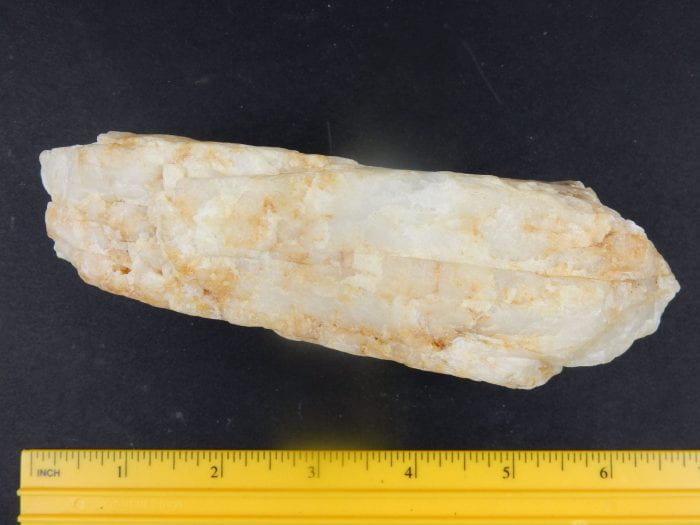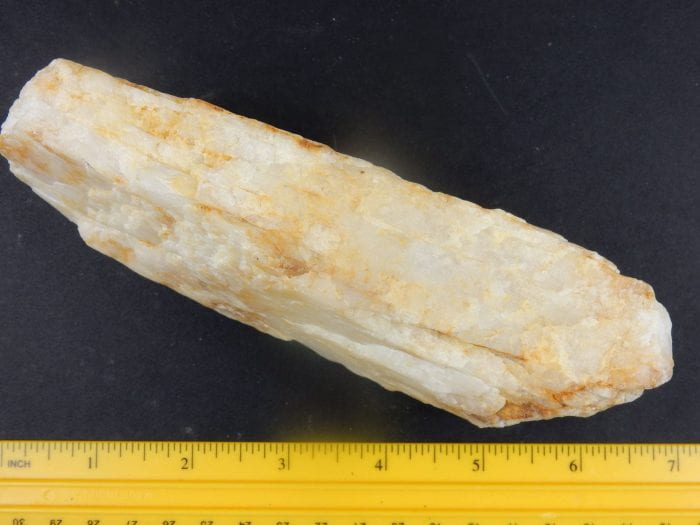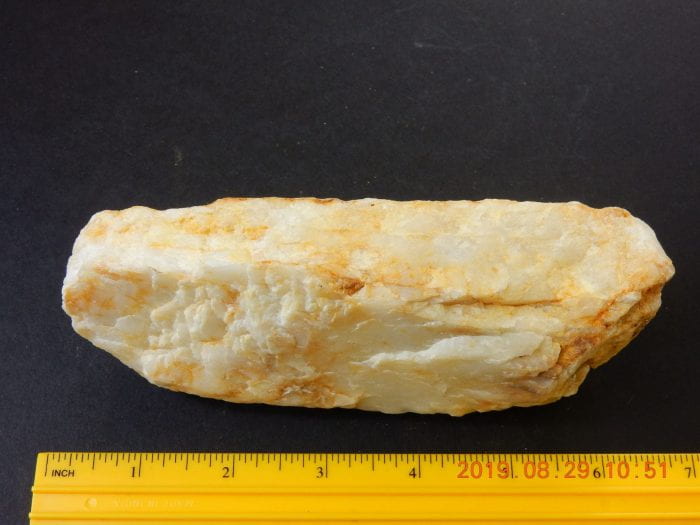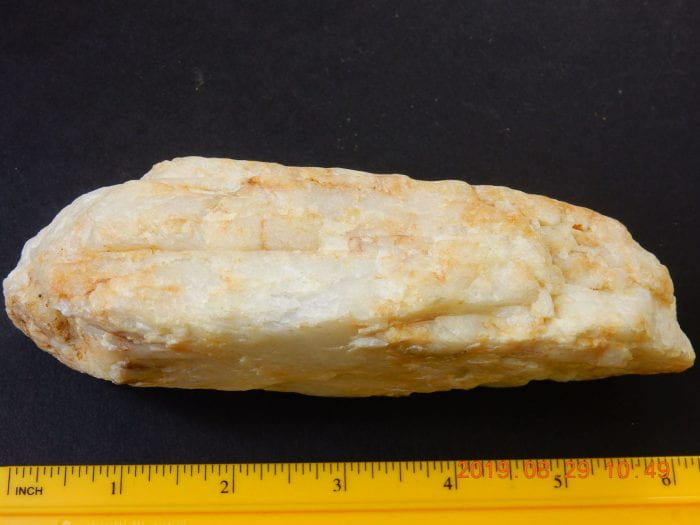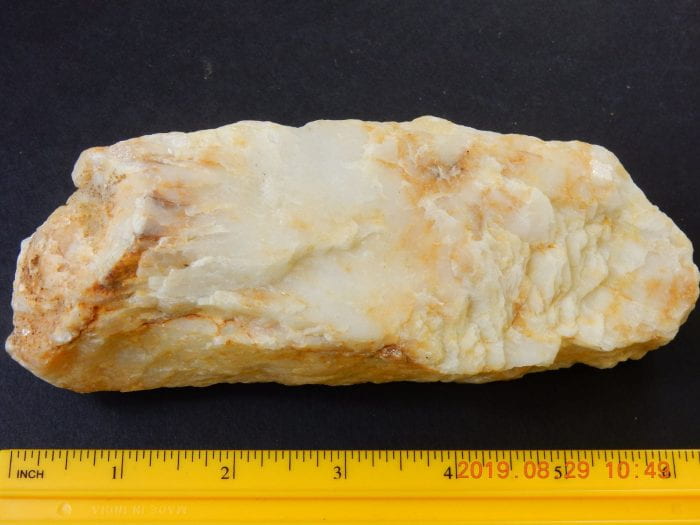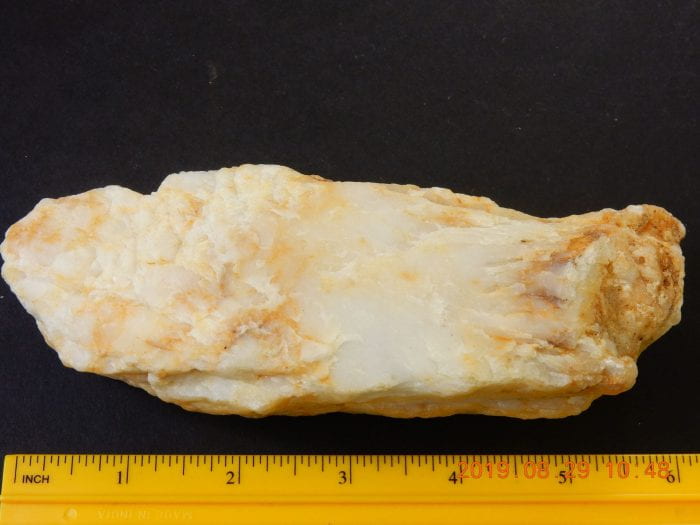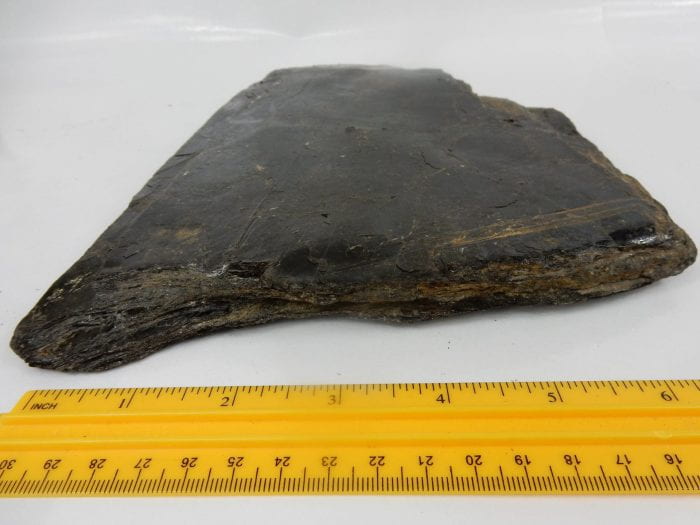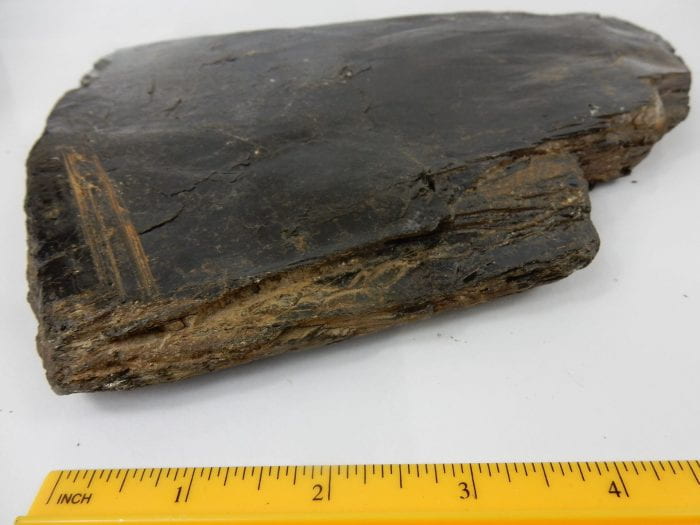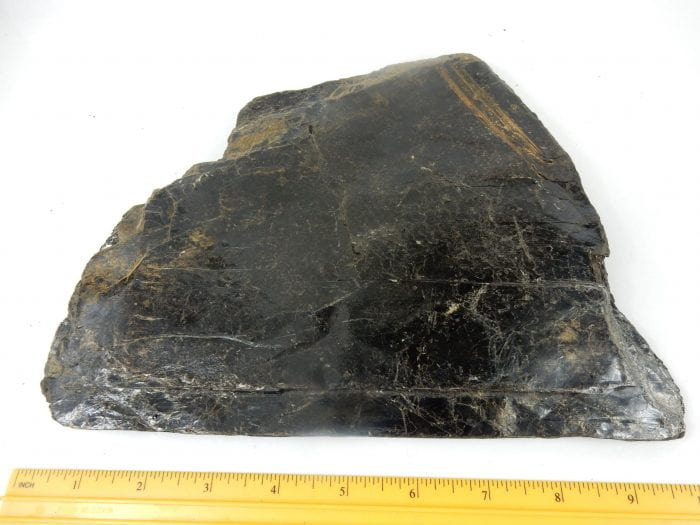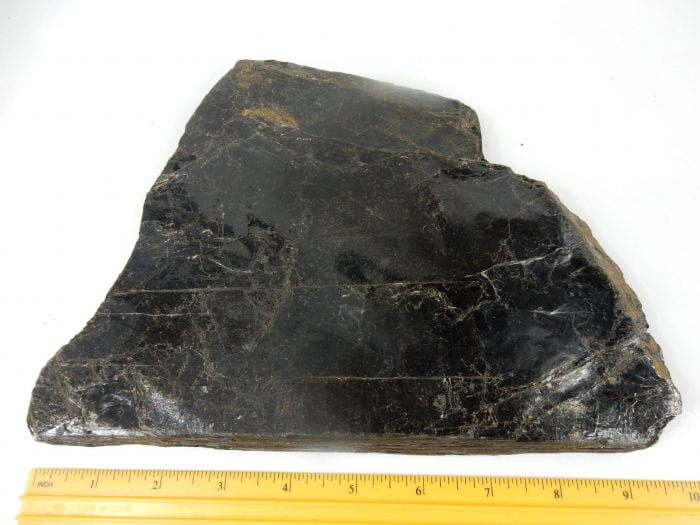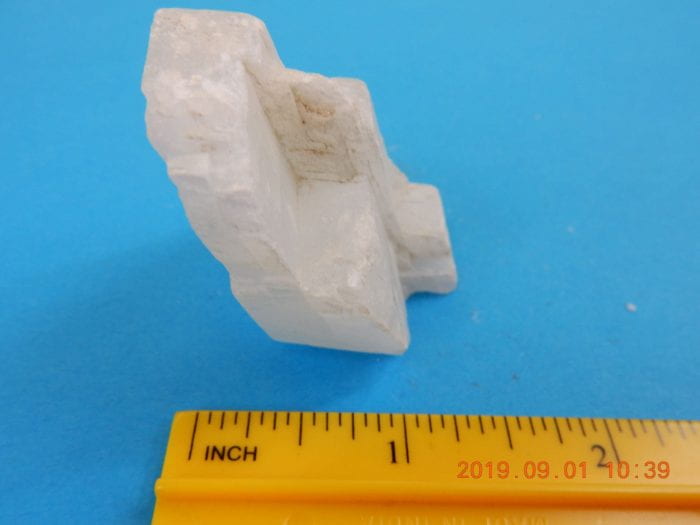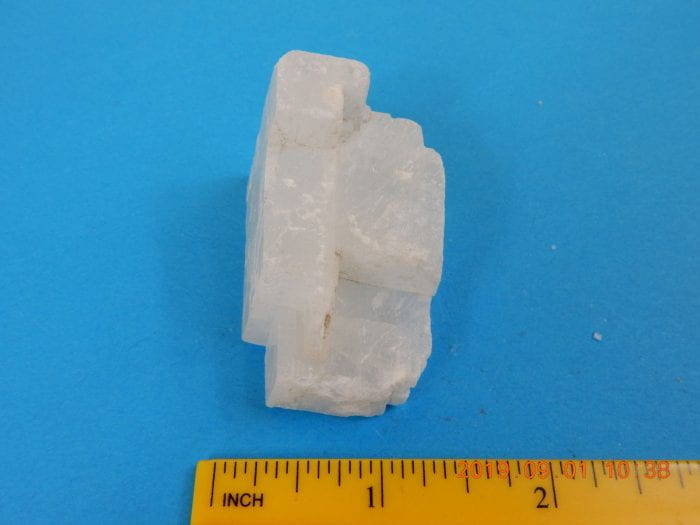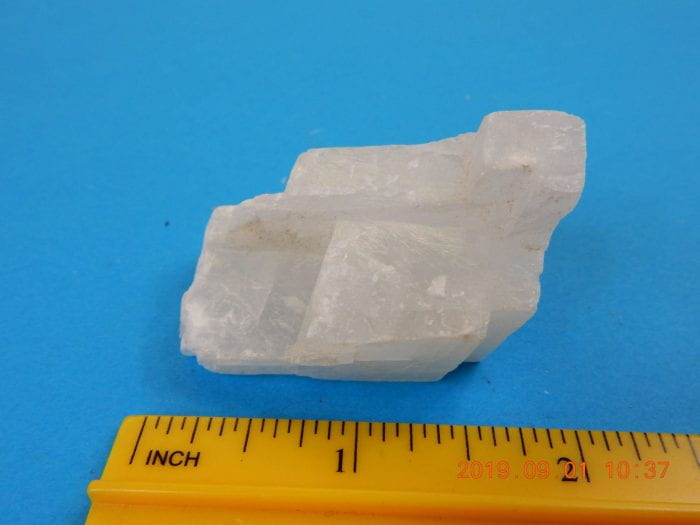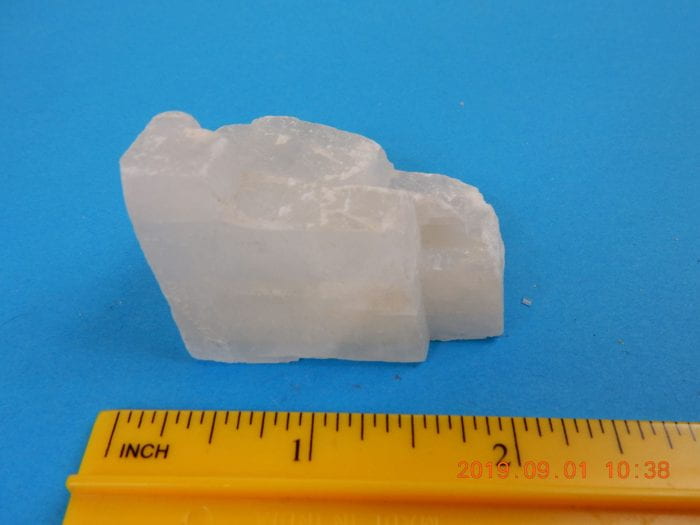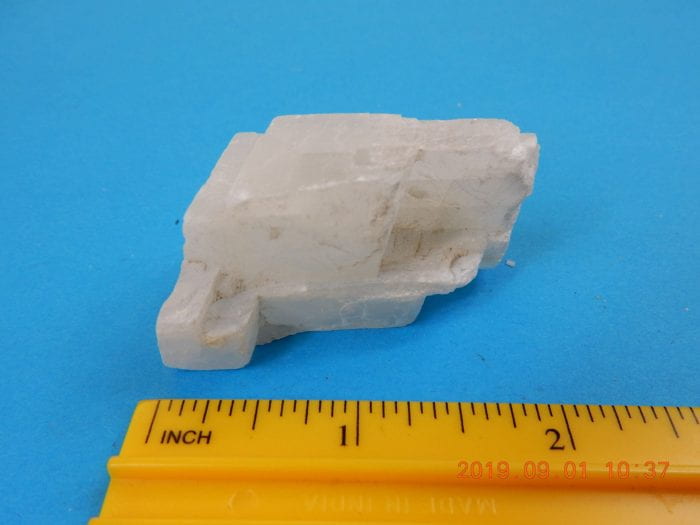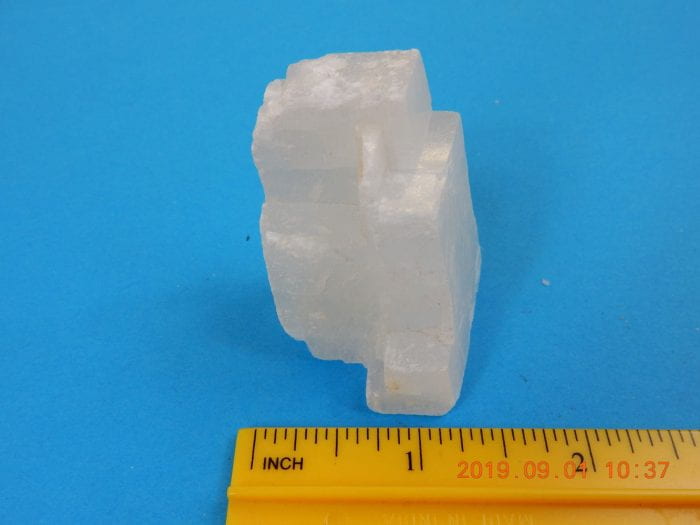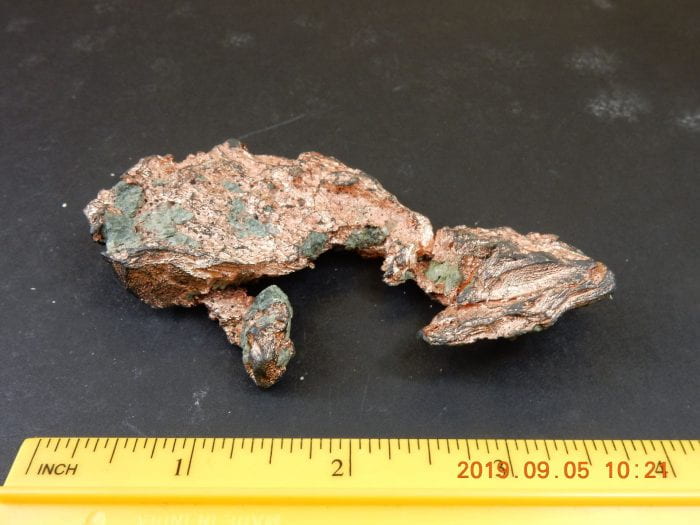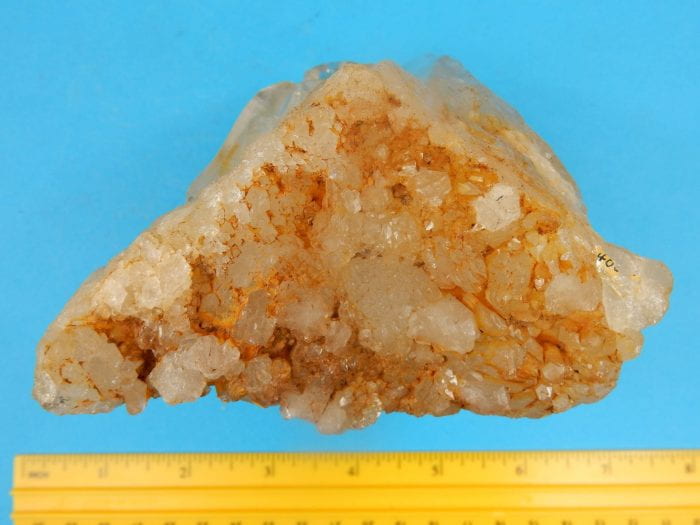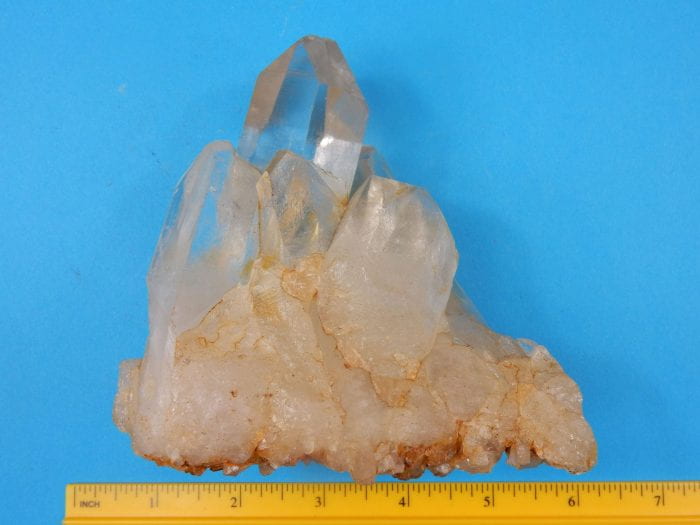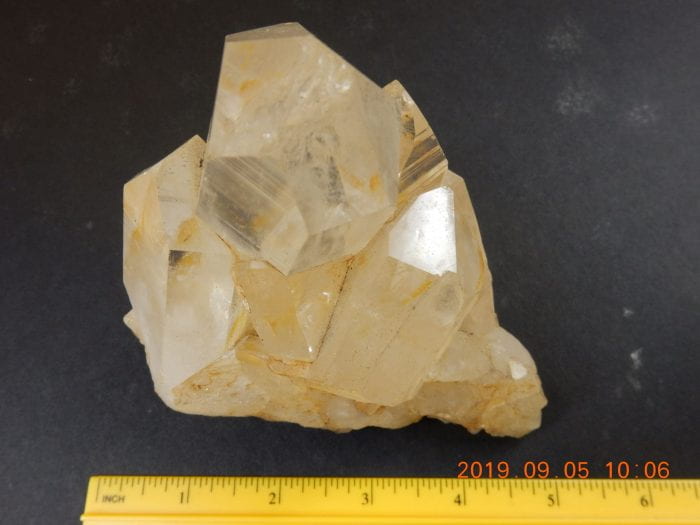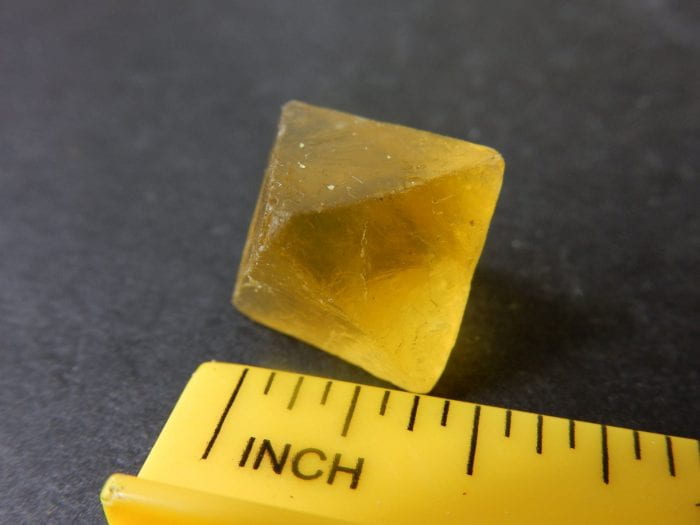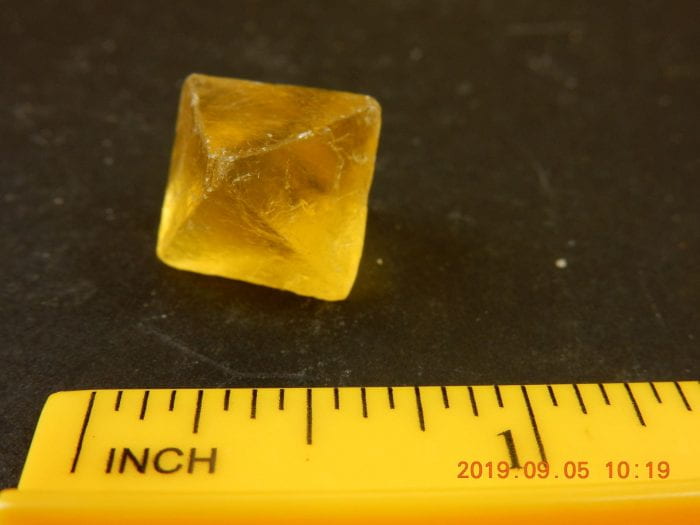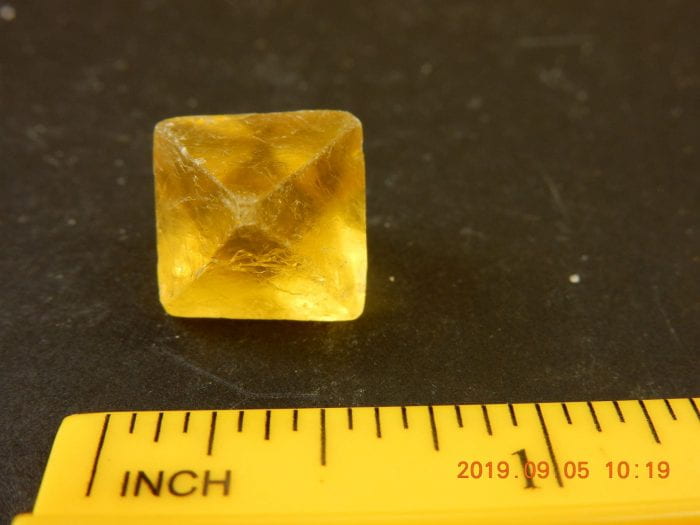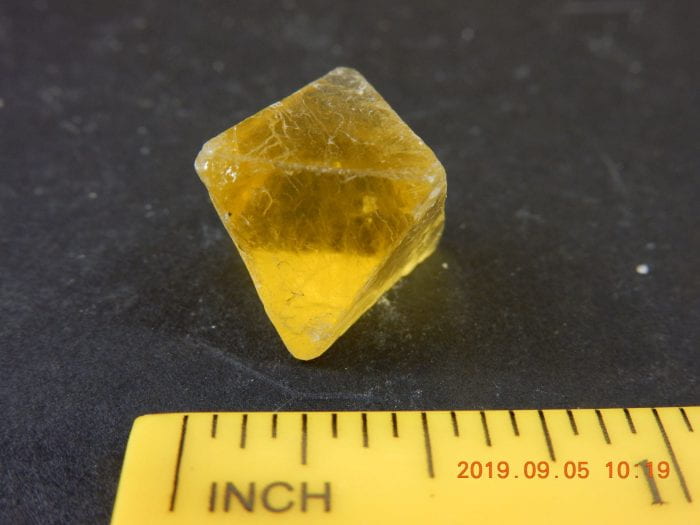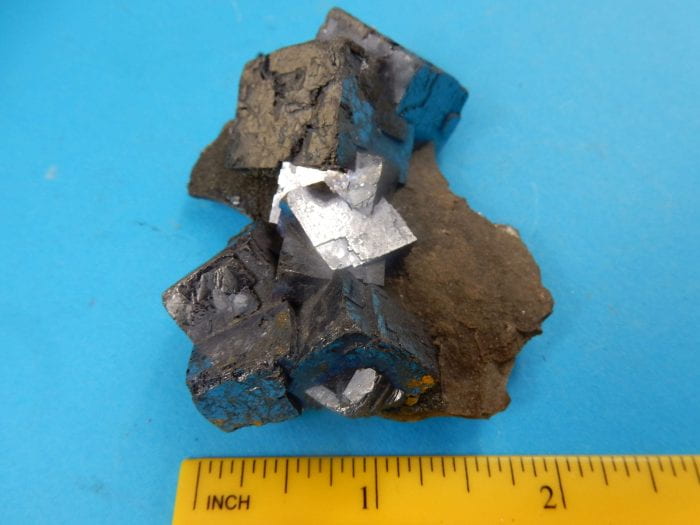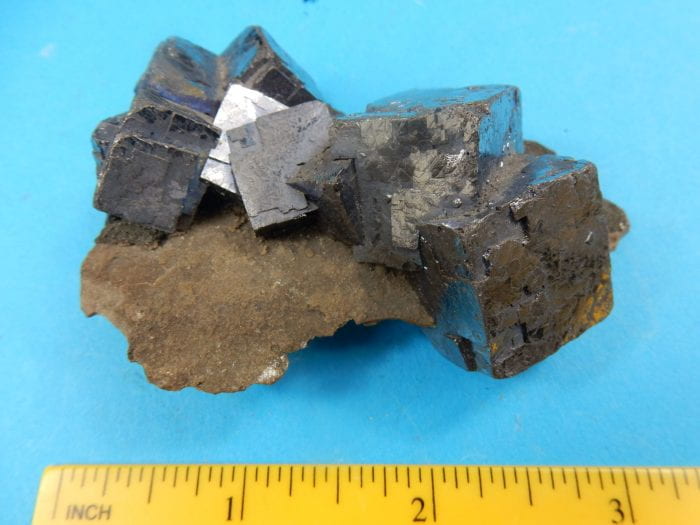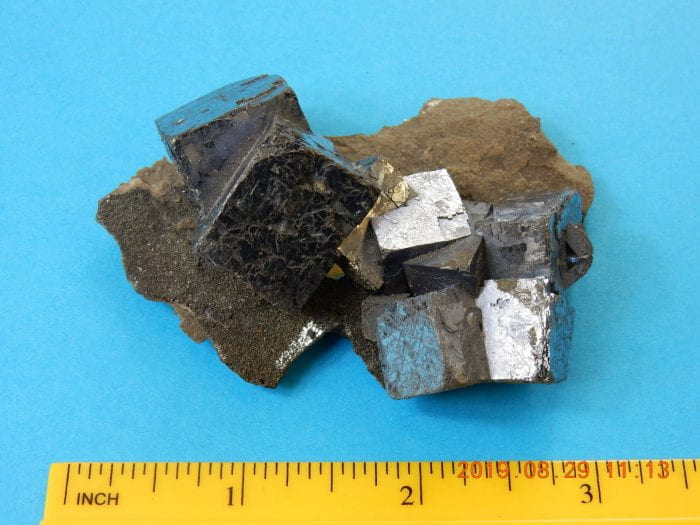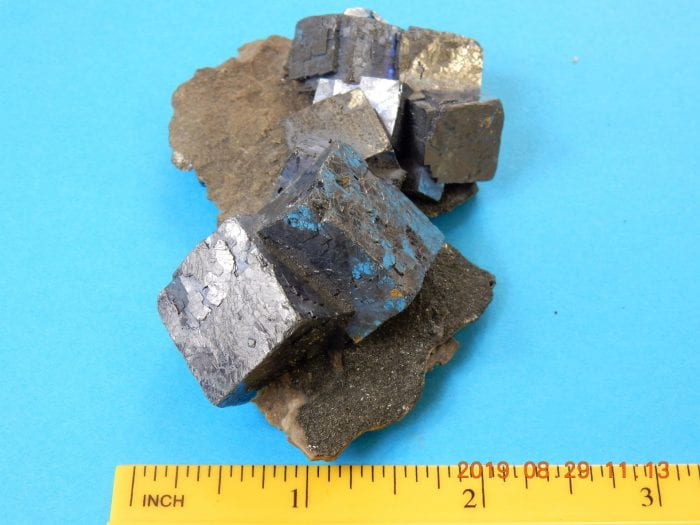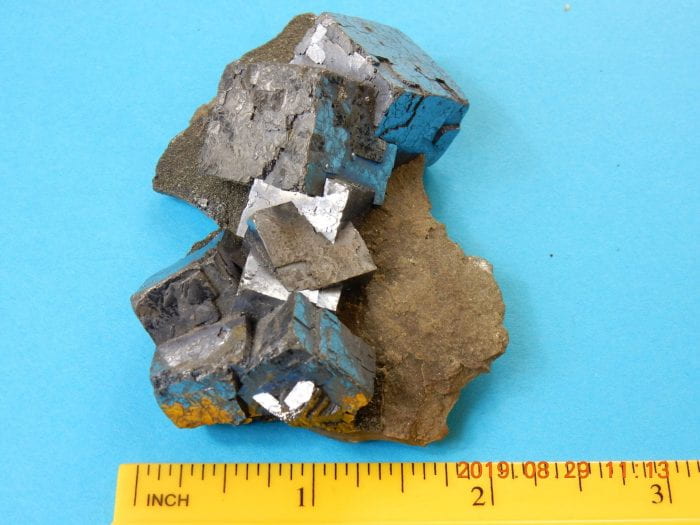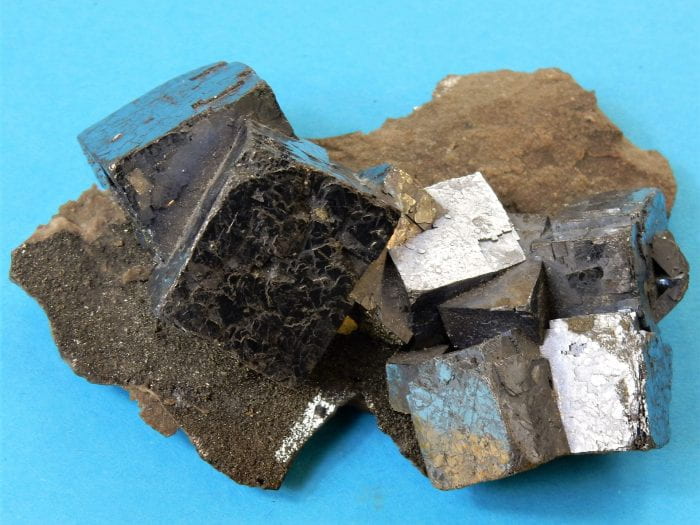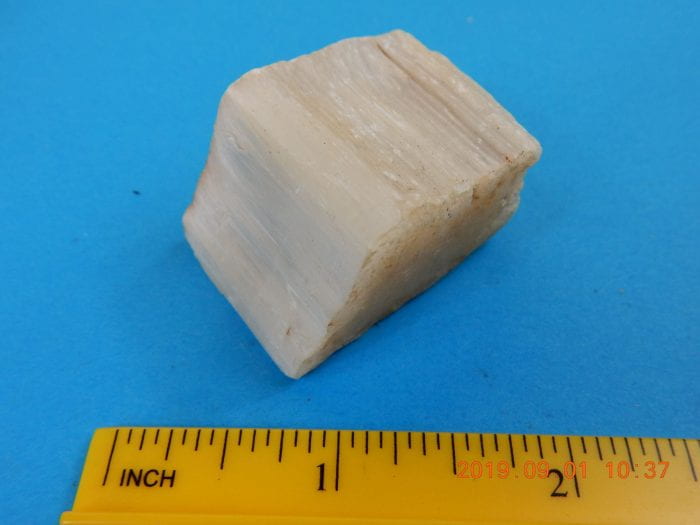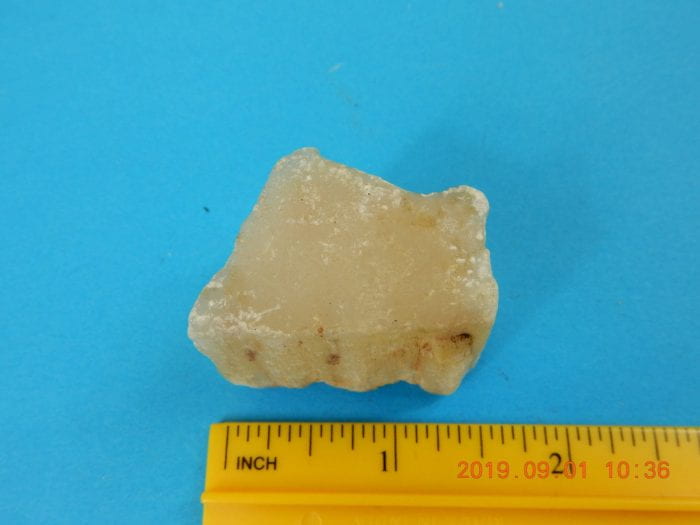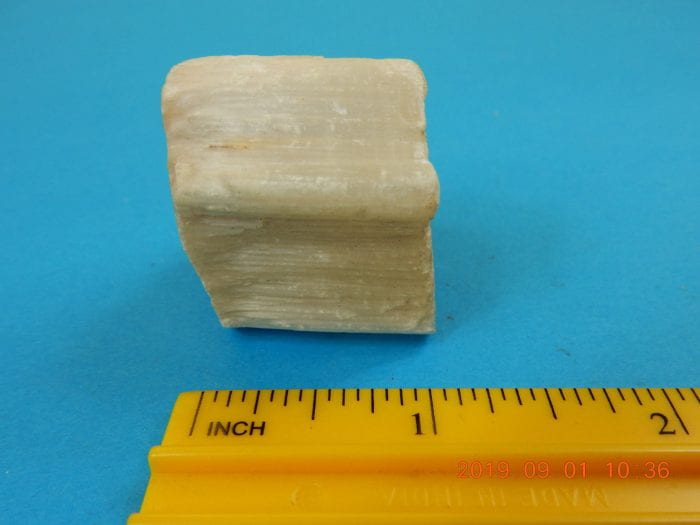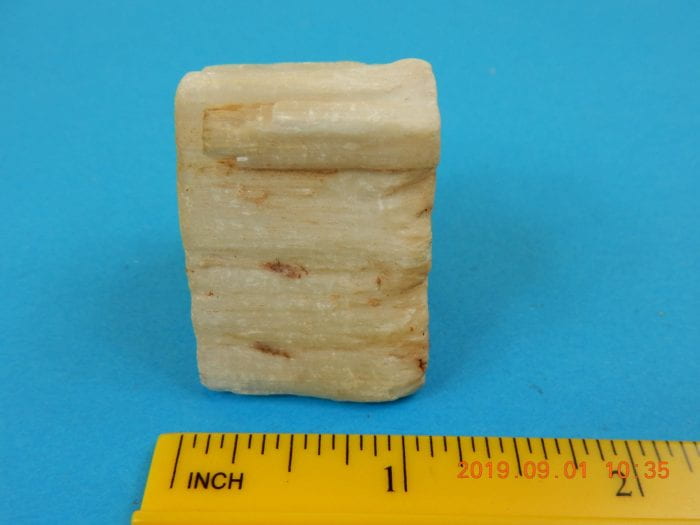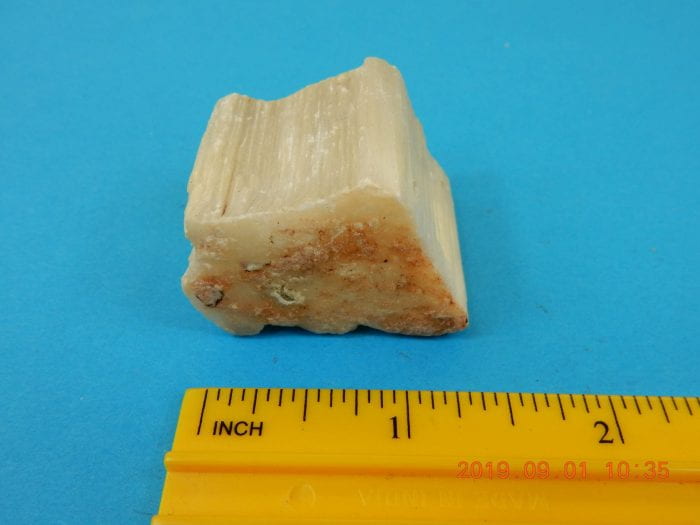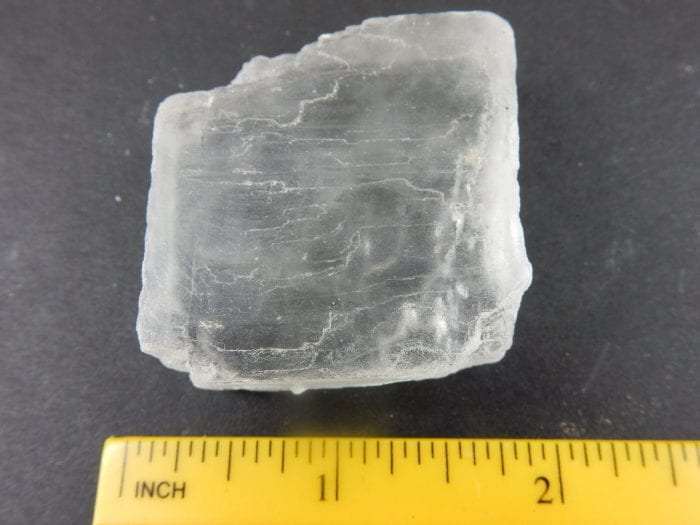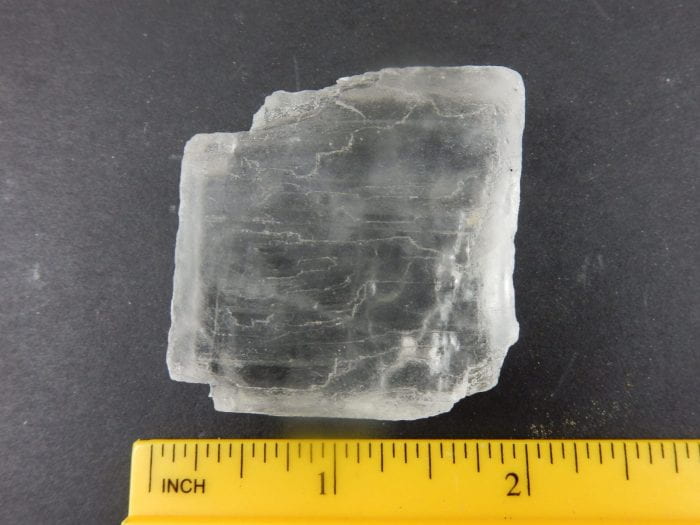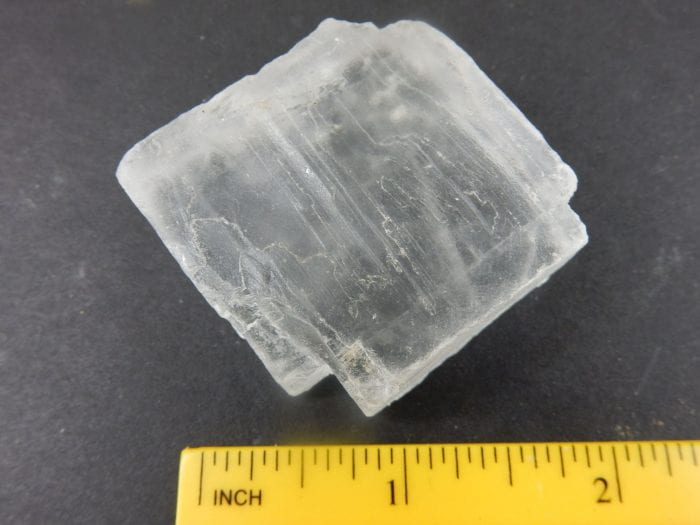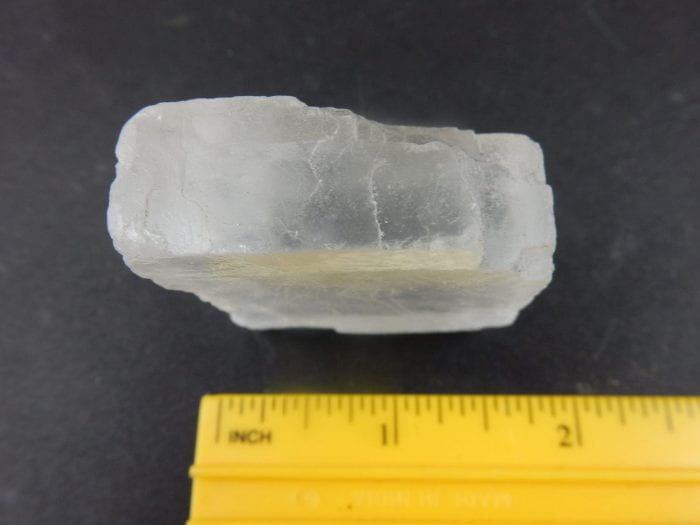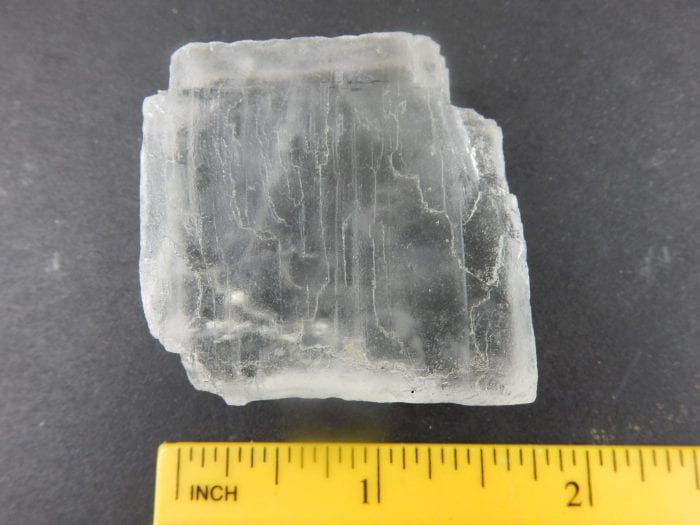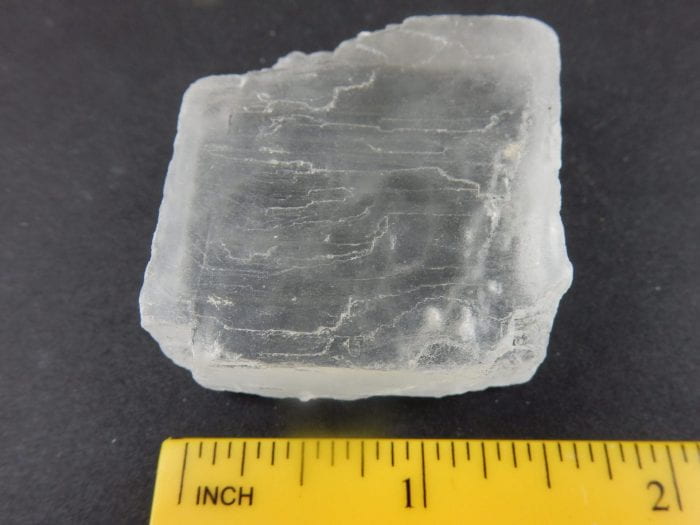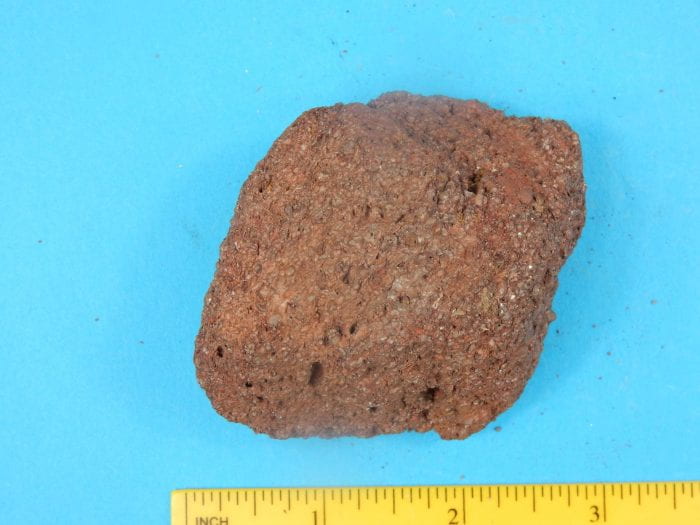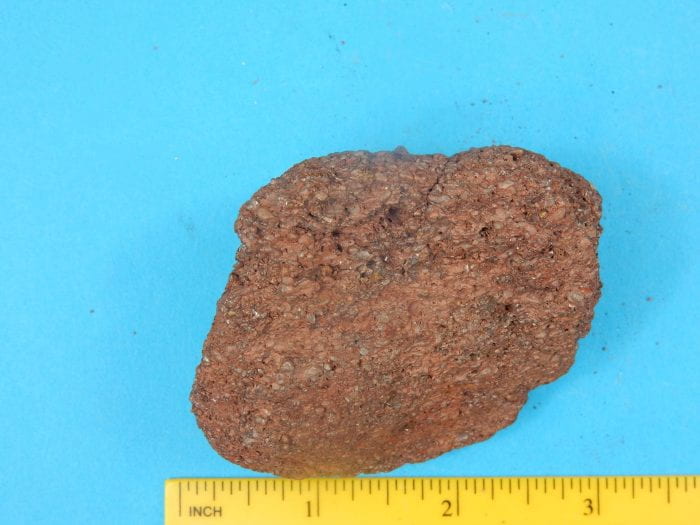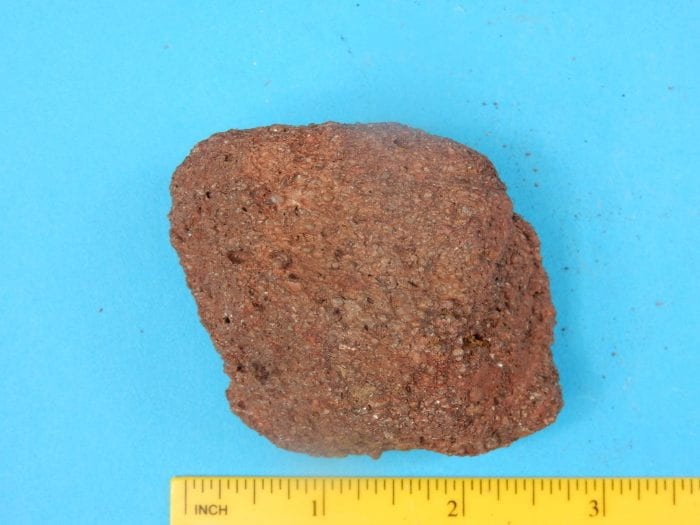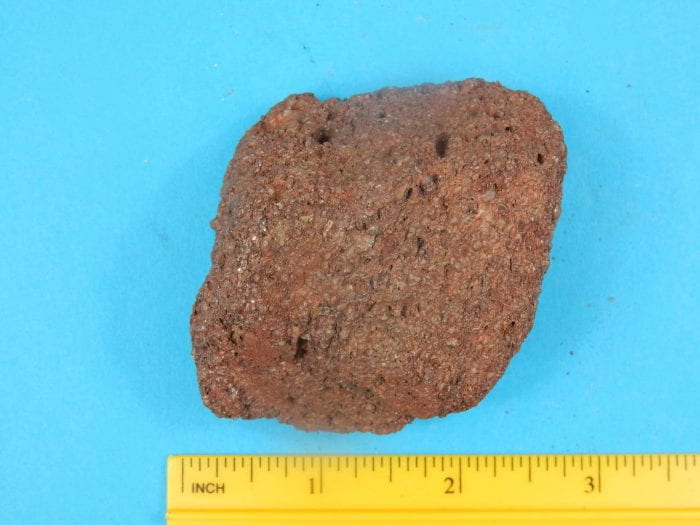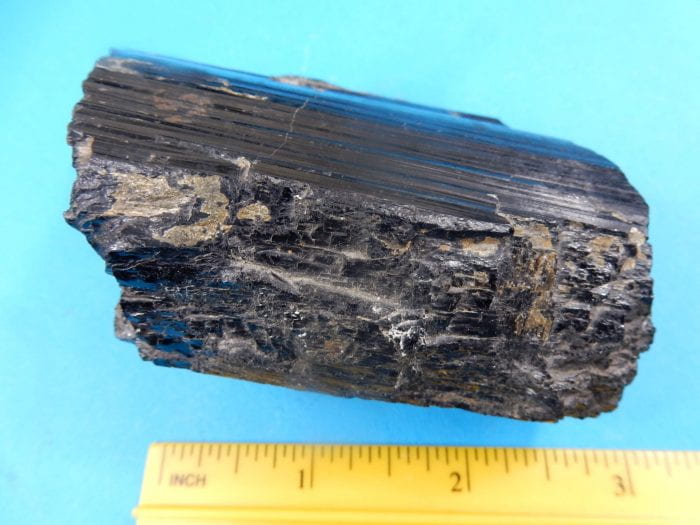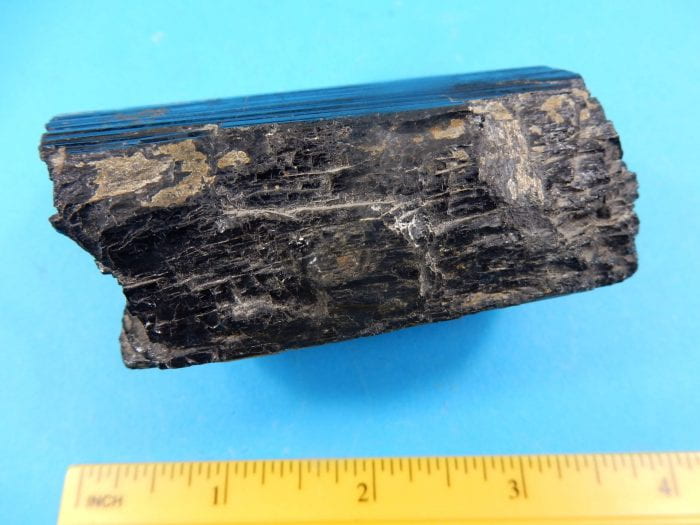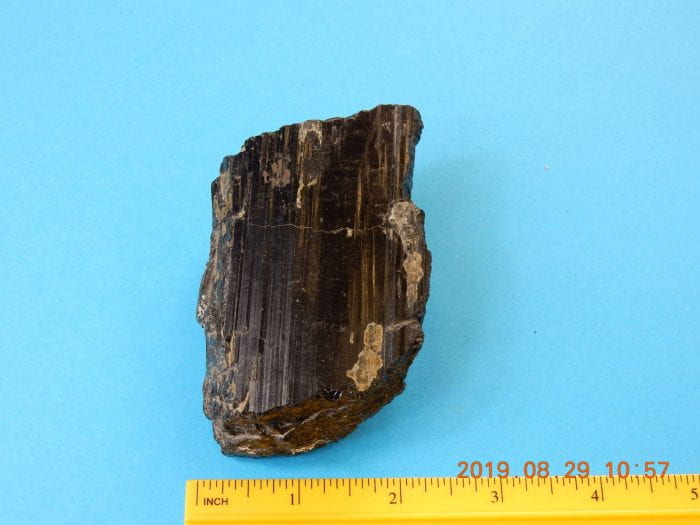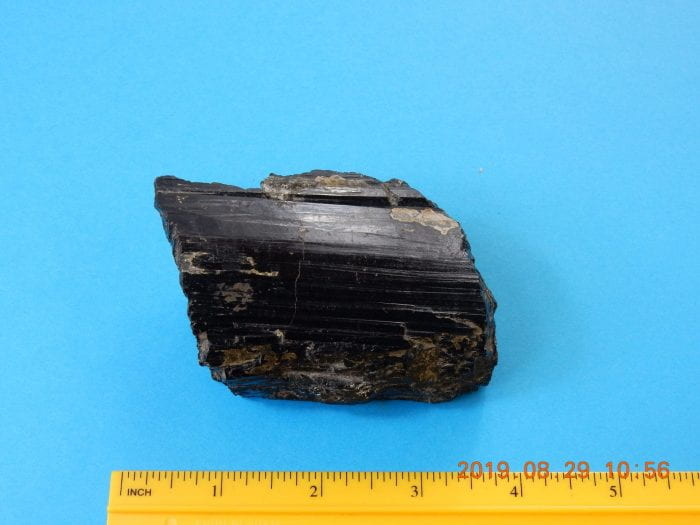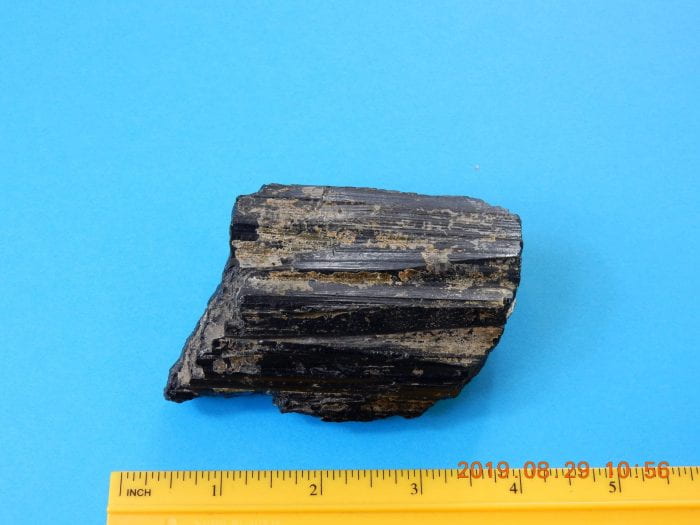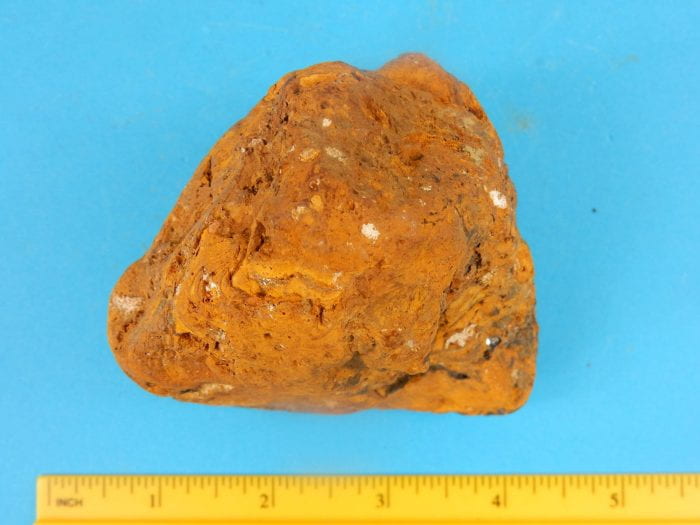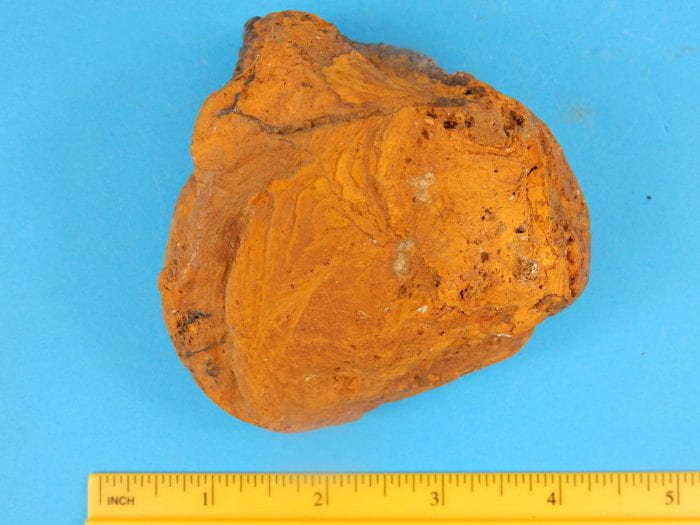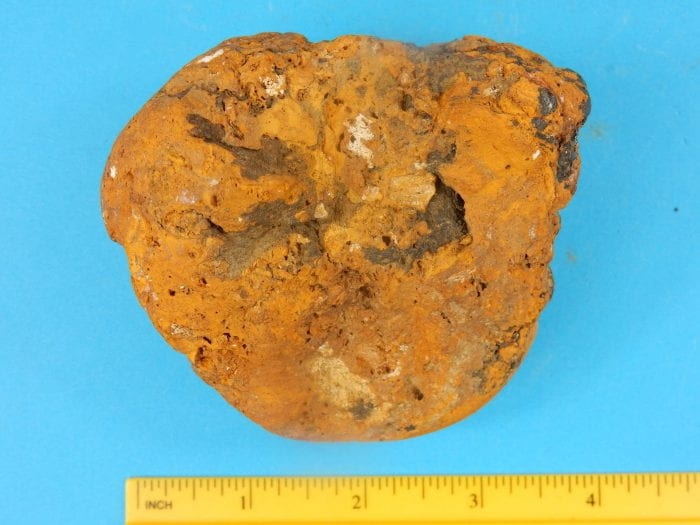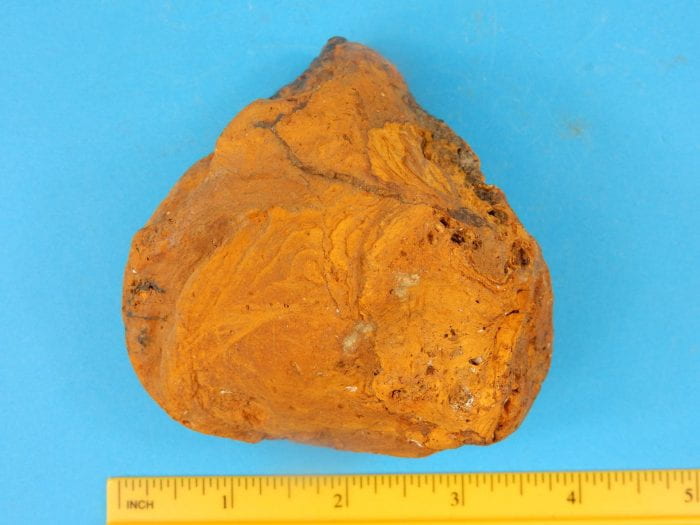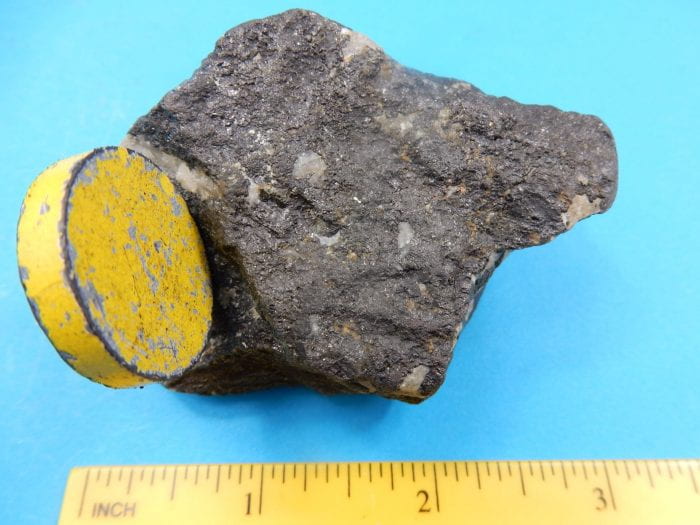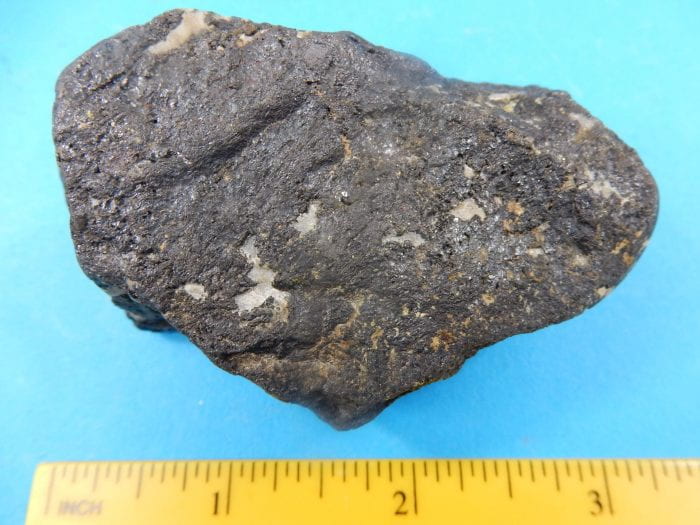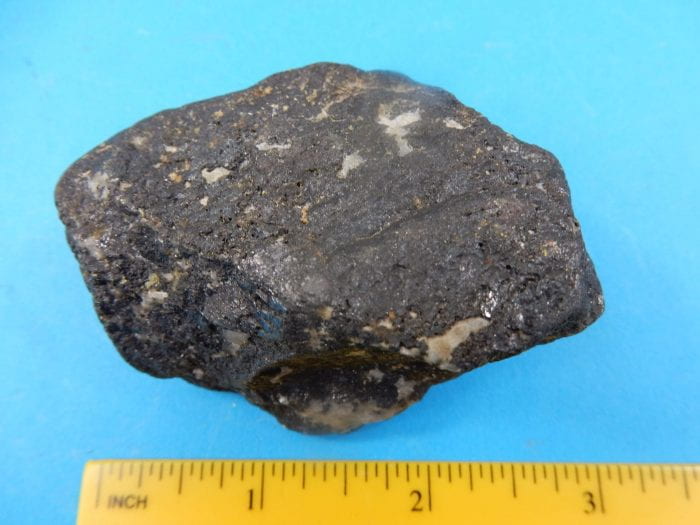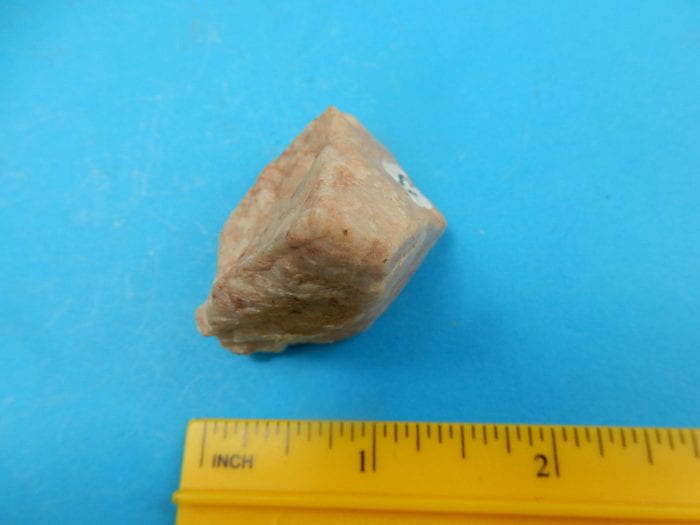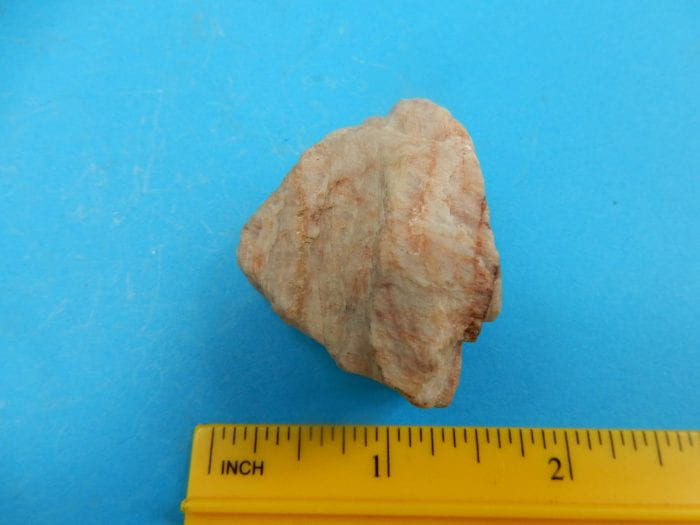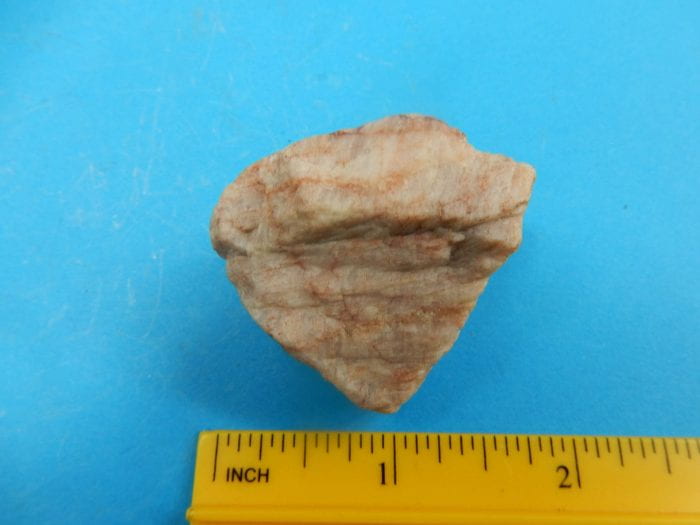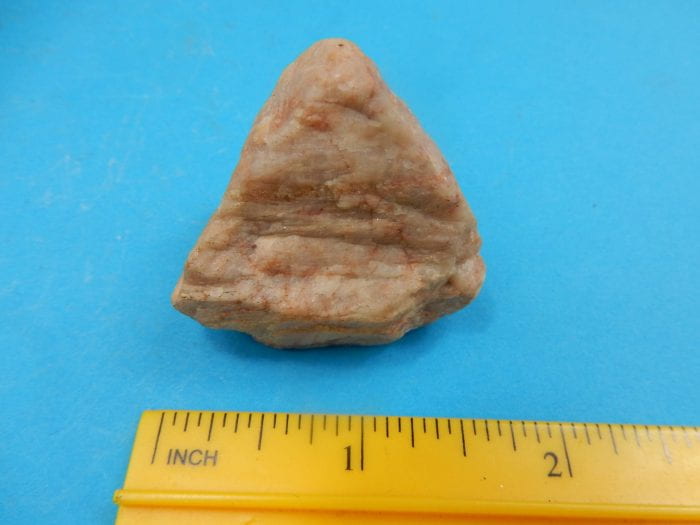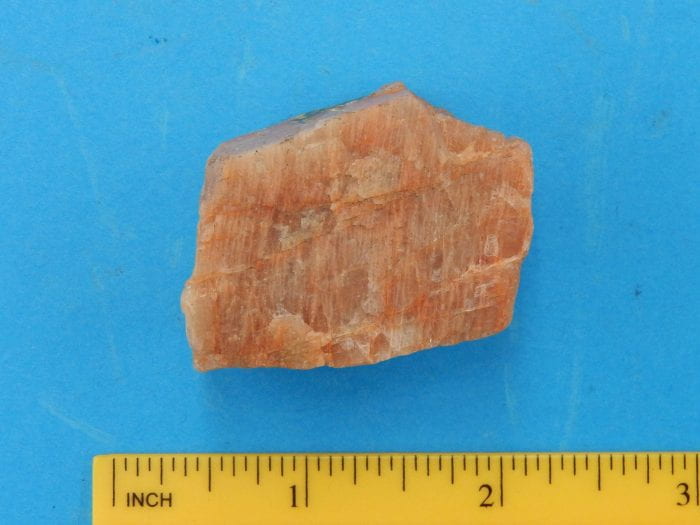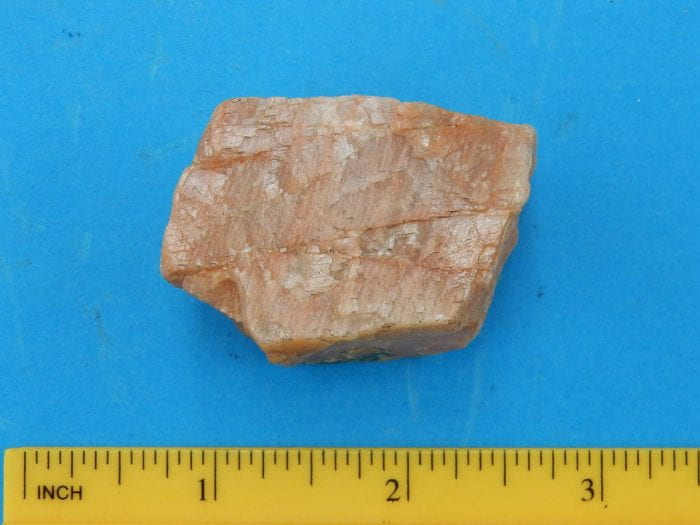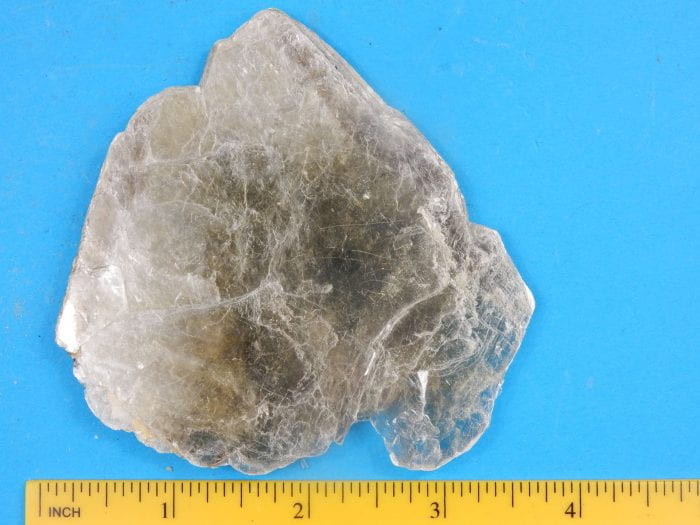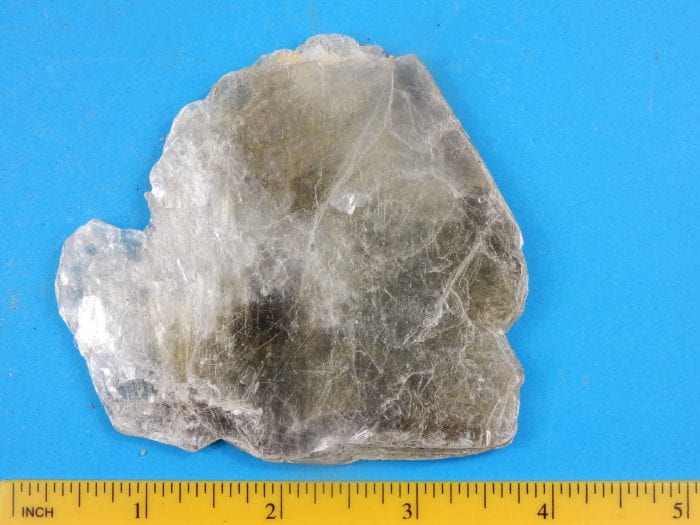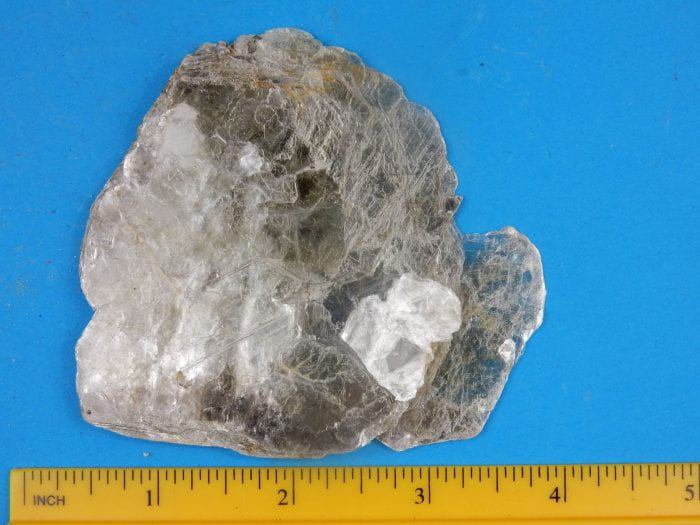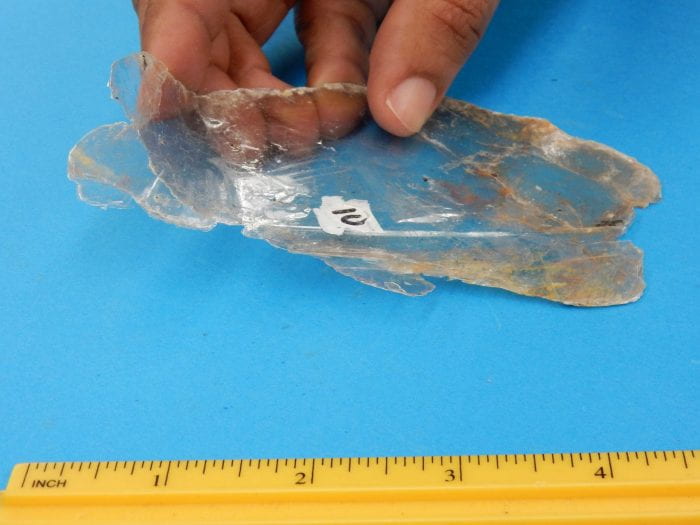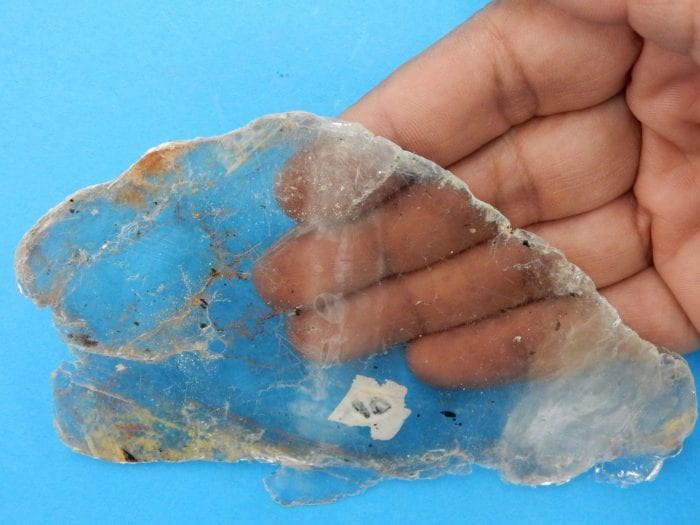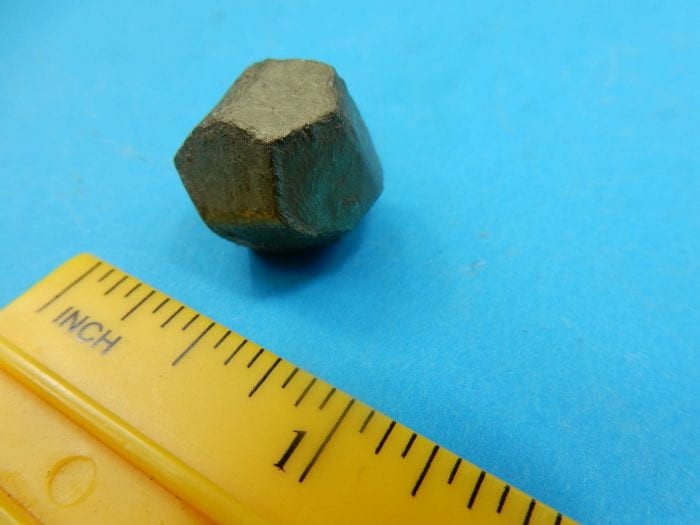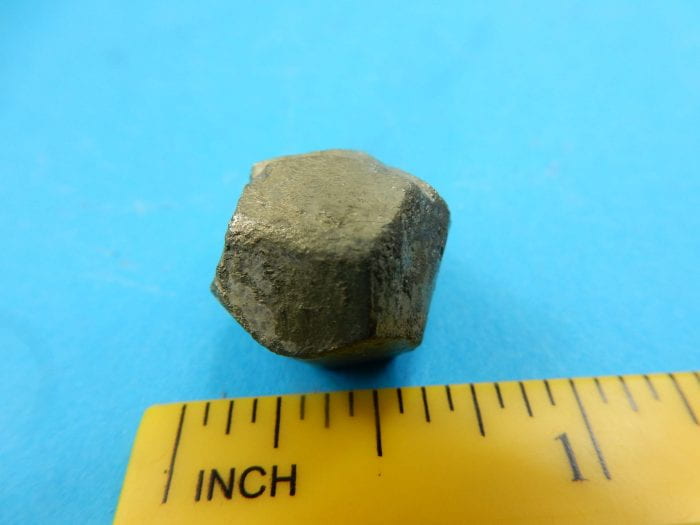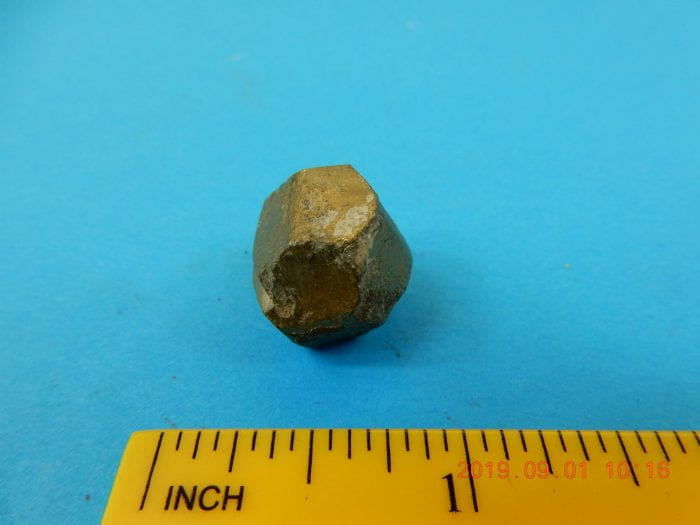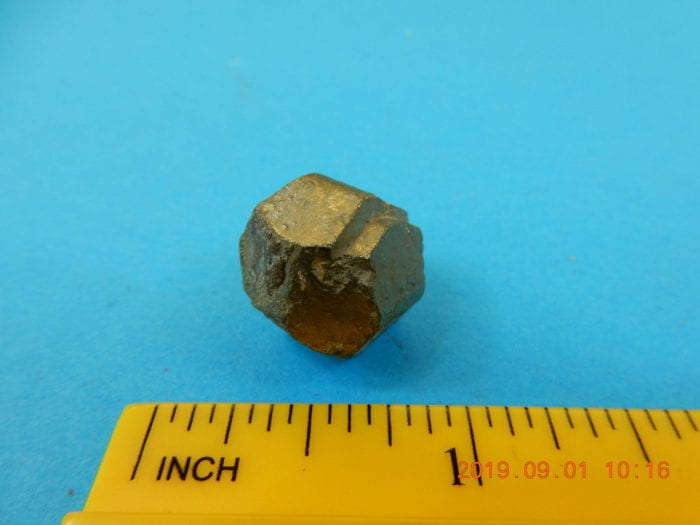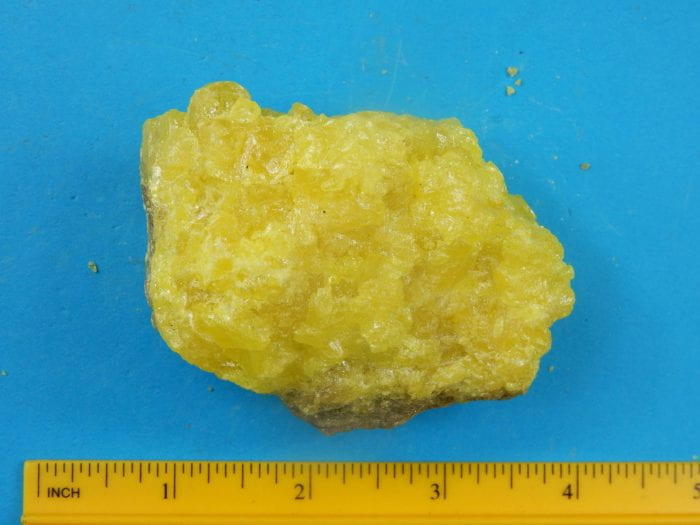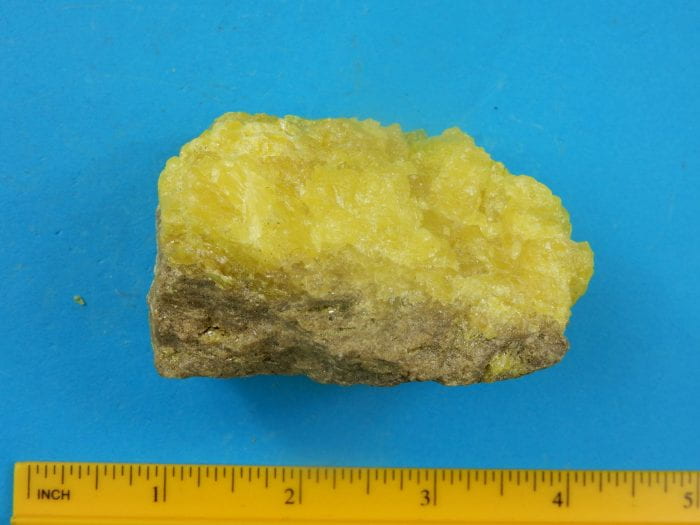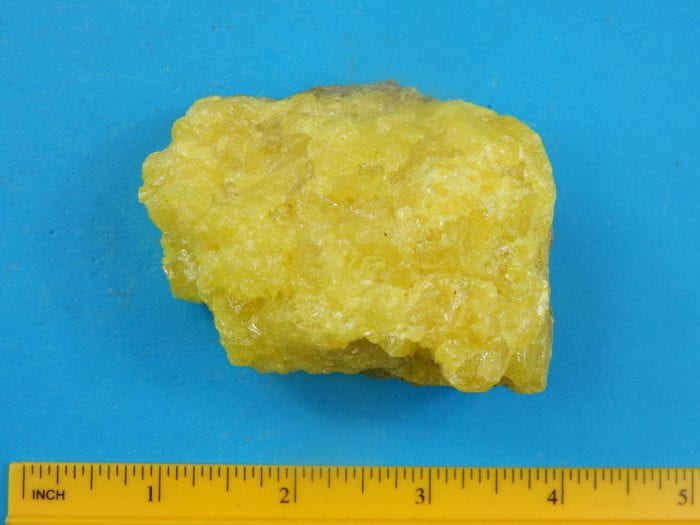Minerals Gallery
Select or click a mineral name to view photos and some facts about the mineral.
Barite
Sample shown is white in color (some light pink areas also present on sample). This sample has a vitreous luster and clearly shows perfect cleavage in one direction (flat smooth surface), the other two directions, although present, not are prominent.
Mineral Group: Sulfates
Physical Properties-Color: WhiteStreak: WhiteHardness: 3 – 3.5Luster: Varies from vitreous to pearly non-metallic lusterCleavage: 3 directions of cleavage, Perfect basal cleavageChemical Composition: BaSO4Crystal System: Orthorhombic
Interesting Fact: Used in drilling muds and the production of paper and plastics.
Biotite
Sample displays a vitreous luster and the flat sheet like form typical of micas is a result of a single direction of cleavage associated with sheet silicates. Biotite is a dark (often black) colored variety of mica.
Mineral Group: Silicate
Physical Properties-Color: BlackStreak: White to greyHardness: 2.5 (on cleavage surface)Luster: VitreousCleavage: Perfect in one direction (basal cleavage)Chemical Composition: K(Mg,Fe2+)3(Al, Fe3+Si3O10)(OH, F)2Crystal System: Monoclinic
Interesting Fact: Sometimes used as a filler in paints.
Calcite
Sample shown is white in color, translucent and exhibits vitreous luster. 3 cleavage planes are nicely shown and results in the rhombohedral form shown.
Mineral Group: Carbonate
Physical Properties-Color: Transparent to translucentStreak: WhiteHardness: 3Luster: VitreousCleavage: Perfect rhombohedral cleavage in 3 directionsChemical Composition: CaCO3Crystal System: Trigonal/Hexagonal
Interesting Fact: Calcite is the chief mineral in the metamorphic rock marble commonly used for buildings and flooring.
Copper
Sample shown exhibits metallic luster and dendritic form.
Mineral Group: Native Element
Physical Properties-
Color: Copper red to pale rose-red
Streak: Copper-red
Hardness: 2.5 – 3
Luster: Metallic
Cleavage: None
Chemical Composition: Cu
Crystal System: Cubic
Interesting Fact: Copper is often used in electrical wiring and in the productions of coins. It is a good conductor of electricity and heat.
Crystalline Quartz
Sample shown exhibits multiple crystals of quarts. Each crystal has vitreous luster and prismatic form characteristic of quartz.
Mineral Group: Silicate
Physical Properties-
Color: Colorless (transparent to translucent)
Streak: None
Hardness: 7
Luster: Vitreous
Cleavage: None
Chemical Composition: SiO2
Crystal System: Trigonal/Hexagonal
Interesting Fact: There are colored varieties of the mineral quartz. The pink variety is called rose quartz, the grey is called smoky quartz and the purple variety is called amethyst. Quartz is often used in the manufacture of glass.
Fluorite
Sample shown is the yellow variety of Fluorite and exhibits vitreous luster and octahedral cleavage.
Mineral Group: Halide
Physical Properties-Color: Variety of colors including green, purple, yellow, pink, red, and colorless.Streak: WhiteHardness: 4Luster: VitreousCleavage: Perfect octahedralChemical Composition: CaF2Crystal System: Cubic
Interesting Fact: Fluorite is also known as Fluorospar and has many useful applications. It is commonly used in the production of ceramics and Hydrofluoric acid for chemical applications.
Galena
Sample shown has multiple cubes of Galena. Each exhibit metallic luster, silver grey color and have a cubic shape.
Mineral Group: Sulfide
Physical Properties-
Color: Lead-grey
Streak: Lead-grey
Hardness: 2.5
Luster: Metallic
Cleavage: Cubic
Chemical Composition: PbS
Crystal System: Cubic
Interesting Fact: Galena is a common source of lead.
Gypsum
Sample shown is white in color and exhibits vitreous luster. The 3 cleavage planes present in gypsum are nicely illustrated.
Mineral Group: Sulfate
Physical Properties-
Color: Colorless (transparent) to brown, red (opaque)
Streak: White
Hardness: 2
Luster: Vitreous
Cleavage: Perfect cleavage in 3 directions
Chemical Composition: CaSO4.2H2O
Crystal System: Monoclinic
Interesting Fact: Gypsum crystals can develop in a radiating pattern forming a rosette commonly called a desert rose. Gypsum has many applications and is commonly used in the manufacture of dry wall, plaster, and as an agricultural soil treatment.
Halite
Sample shown is transparent and exhibits a vitreous (glassy) luster. The 3 cleavage planes (all perpendicular to each other) characteristic of halite identifiable.
Mineral Group: Halide
Physical Properties-
Color: White (transparent to translucent)
Streak: White
Hardness: 2
Luster: Vitreous
Cleavage: Cubic
Chemical Composition: NaCl
Crystal System: Cubic
Interesting Fact: This mineral has a salty taste and is often called “rock salt.”
Hematite
This sample has a brownish red color and a dull luster. Hematite can occur in a variety of forms. In this sample the individual minerals occur as small round spheres.
Mineral Group: Oxide
Physical Properties-
Color: Brown, red, brownish-red, black, steel grey
Streak: Red or red-brown
Hardness: 5 – 6
Luster: Metallic to dull
Cleavage: None
Chemical Composition: Fe2O3
Crystal System: Trigonal/Hexagonal
Interesting Fact: Hematite is widely used as a source for iron.
Hornblende
Sample shown is black in color and exhibits cleavage planes and vitreous luster associated with Hornblende
Mineral Group: Silicate
Physical Properties-
Color: Black, dark brown, dark green
Streak: White or grey
Hardness: 5 – 6
Luster: Vitreous
Cleavage: 2 cleavage planes; angle of 60° or 120° between cleavage planes
Chemical Composition:
Crystal System: CA2(Mg,Fe)4Al(Si7Al)O22(OH,F)2
Interesting Fact: Hornblende is the most abundant mineral Amphibolite often used for decorative stone called “black granite.”
Limonite
This sample has a brownish yellow color and dull luster. Sample has a granular appearance.
Mineral Group: Hydroxides
Physical Properties-
Color: Yellow, brownish-yellow, brown and blackish
Streak: Yellow-brown
Hardness: 4 – 5.5
Luster: Earthy, dull
Cleavage: None
Chemical Composition: FeO(OH).nH2O
Crystal System: Undefined
Interesting Fact: Limonite was used by early man as a pigment in Neolithic cave paintings.
Magnetite
Sample shown has multiple crystals of magnetite. This mineral is magnetic illustrated by the yellow magnet attracted to sample. Mineral is black in color with a dull luster.
Mineral Group: Oxide
Physical Properties-
Color: Black or brownish-black
Streak: Black
Hardness: 5.5 – 6.5
Luster: Dull to metallic
Cleavage: None
Chemical Composition: Fe2+Fe3+2O4
Crystal System: Octahedral
Interesting Fact: This mineral is magnetic, metallic objects will be attracted to it!
Microcline or Potassium Feldspar
Sample shown exhibits the classic salmon-pink color of Potassium feldspar. Cleavage planes are also clearly shown.
Mineral Group: Silicate
Physical Properties-
Color: Pink, Salmon-Pink, White, Grey, Tan
Streak: White
Hardness: 6 – 6.5
Luster: Vitreous
Cleavage: Perfect cleavage in 2 directions
Chemical Composition: KAlSi3O8
Crystal System: Triclinic
Interesting Fact: Often used in the production of porcelain and can sometimes be used in the manufacture of glass.
Muscovite
Sample displays a vitreous luster and flat sheet like form typical of micas. Muscovite is light colored variety of sheet silicate. Single layers of muscovite can bend and are described as elastic. Individual sheets or thin layers will be transparent.
Mineral Group: Silicate
Physical Properties-
Color: Varies from colorless to white or grey
Streak: Colorless
Hardness: 2.5 – 4
Luster: Vitreous to pearly non-metallic luster
Cleavage: Perfect basal cleavage
Chemical Composition: KAl2(Si3Al)O10(OH,F)2
Crystal System: Monoclinic
Interesting Fact: This mineral has an elastic property, it’s flexible.
Muscovite is used in paint, wallpaper, and even eye makeup to give that glittery appearance.
Pyrite
Sample shown is a single pyritohedron shaped crystal of pyrite. The mineral has a gold colored appearance, this has led to this mineral being commonly referred to as fool’s gold.
Mineral Group: Sulfide
Physical Properties-
Color: Pale yellow colorStreak: Greenish black – brownish black
Hardness: 6 – 6.5
Luster: Metallic
Cleavage: none
Chemical Composition: FeS2
Crystal System: Isometric (cubic)
Interesting Fact: This mineral can spark when struck with a hard metal object. Pyrite is also referred to as fool’s good.
Sulfur
Sample shown has multiple crystals of sulfur. They are yellow in color and have a resinous luster.
Mineral group: Native mineral
Physical Properties-
Color: Bright yellow to yellowish brown
Streak: White
Hardness: 1.5-2.5
Luster: Varies from Resinous to greasy Non-metallic luster
Cleavage: Imperfect basal
Unique properties: Has a distinct odor –sulfur dioxide)
Chemical composition: S
Crystal system: Orthorhombic
Interesting Fact: Typically forms around volcanic craters and hot springs. Easily recognized by its scent; it smells like rotten eggs!
References
- Geologyscience.com (2021). Microcline. [online] Available at: https://geologyscience.com/minerals/microcline/ [7th June 2021 ]
- Pellant, C. (1992). Rocks and minerals. 1st American ed. New York: Dorling Kindersley.

